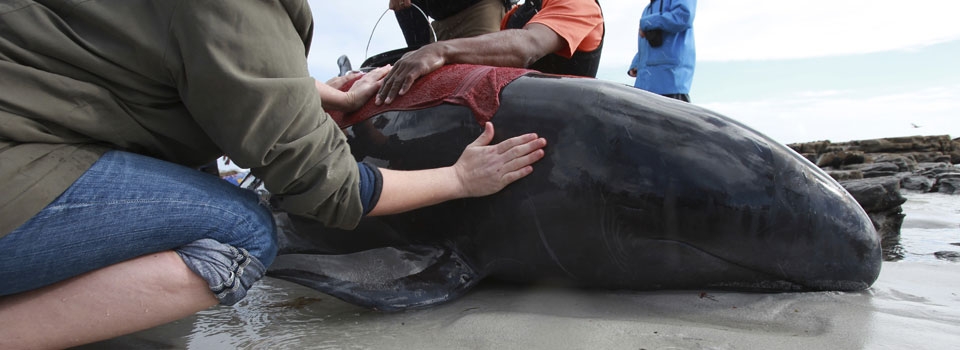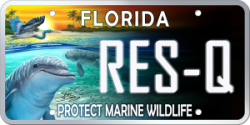- RESEARCH
- LEARN
- Camps »
- Resources »
- Kids Zone »
- SHOP

- Providing Sanctuary and a Forever Home since 1984.
- A not-for-profit 501(c)3 marine mammal education and research facility for more than 35 years.
- Providing Sanctuary and a Forever Home since 1984.
A not-for-profit 501(c)3 marine mammal education and research facility for more than 35 years.
Strandings Case Studies
Stranding Case Studies
Dolphin Research Center Marine Mammal Rescue Team shares past experiences
Many animals have come into our lives and touched our hearts. In the following stories, we try to share some of the poignancy and privilege of our encounters with these visitors from the sea.
Case Study: A Different Kind Of Dolphin
A Different Kind Of Dolphin
On a Saturday morning in October 1987, a local fisherman called DRC with the news that he had brought a dolphin into the Sugarloaf Marina, some 15 miles north of Key West. This was not the dolphin fish that local fishermen usually catch in the Keys, but the mammal dolphin, and a very small one at that.
The fisherman had discovered the dolphin swimming slowly on the surface in a channel just off Sugarloaf Key. Since the dolphin appeared sick to the fisherman, and he had seen several large bull sharks in the area only a short time before, he had maneuvered the boat slowly over to the small creature. The dolphin responded by swimming close to the boat and allowing the fisherman to pick her up gently and place her into the boat without a struggle. The fisherman, rather astutely, kept the dolphin cool and wet in his boat for the 30-minute ride to the marina, where the DRC team soon met him.
The tiny dolphin fit easily in the back of a station wagon for the return trip to DRC, thus eliminating the search for a transport vehicle. Her unique characteristics included a long, slender snout, two-toned markings of light and dark gray, and a small, elongated body. What had been reported as a baby bottlenose dolphin turned out to be a different species all together. Although there was disagreement amongst several researchers, the authority on this type of dolphin identified her as a Stenella attenuata, commonly referred to as a Pantropical spotted dolphin. Her length of 4’5” placed her age around 12-14 months—too young to have the spots that are characteristic of the adults.
Upon arriving at DRC, we tried to feed our thin new charge. She was so small, she could be held in one arm and fed with the other. The dolphin was apparently hungry, because she ate quite well. She was named Dart, because of her slender, tapering shape, and the way she darted around.
The marine mammal veterinarians whom we consulted could not believe that the baby Stenella had even survived the trip. No member of this species had ever survived in human care because of a low tolerance to stress. Little did they realize Dart was to beat the odds and live with the DRC family for three years, finding a place deep in our hearts and the hearts of our visitors. Dart arrived at DRC at the height of the dolphin/tuna controversy, and became the “spokes-dolphin” for our letter-writing campaign. Dart helped save many dolphin lives by inspiring people to take a stand against the frightfully high mortality rate of spotted dolphins in the Eastern Tropical Pacific. The total mortality figure for incidental dolphin kills in 1988 was almost 79,000; in 1999 it was less than 2,000.
Why Dart stranded is uncertain. She was a young animal, judging by her size and lack of spots. Perhaps Hurricane Floyd, which swept the area two weeks prior to her stranding, had separated Dart from her mother and the rest of her pod. We can only speculate.
Dart seemed to be failing shortly after her arrival at DRC. She was lethargic; she was not eating. It didn’t look good. Back then, we used a pool at DRC adjacent to our dolphins’ pools for small stranded animals, a practice we since have discontinued to prevent any possibility of disease transmission to our colony. Dart was in a shallow pool next to our maternity pool, where a mother dolphin named Bee lived. Bee, who was pregnant at the time, seemed fascinated with her small neighbor, spending a lot of time watching her through the divider fence. Once we felt we had nothing to lose, we opened the gate to see what Bee would do.
Bee immediately went to Dart and began swimming with her in the echelon position, which a mother dolphin will use to guide her calf. From that time on and continuing after the birth of Bee’s own calf, Dart was a member of the family. Is this why she survived? We don’t know, but it was clear that she had been accepted into our bottlenose dolphin pod. Not only that, but Dart clearly accepted the human family at DRC. She was often the first at the dock when we came to visit her pool, whether for a formal session, or just to play.
We could not in good conscience release Dart because she would have been no better off than when we rescued her. It was unusual to find this kind of dolphin in the coastal waters of the Florida Keys since Stenellas normally inhabit deep oceanic waters of the Atlantic and Pacific. We could not locate a pod of her species close enough to DRC to minimize the transport time and stress that could so easily have killed her.
We lost Dart in November of 1990 to a raging viral infection that came on very suddenly. She never gave us a clue that something was wrong until about two days before she died. We tried the best that marine mammal medicine had to offer, but it was too late to help.
Dart was truly one-of-a-kind. For such a small creature, she left an awfully big hole in our lives when she left us. Though we still miss her, we will always cherish the three years she spent with us: for the pivotal role she played in the dolphin/tuna issue, the tremendous opportunity she gave us to learn about her species, and, most of all, the privilege of getting to know a bright and delightful being.
Case Study: Cold Front
Cold Front
One of the more commonly stranded whales in the Florida Keys is the pygmy sperm whale, Kogia breviceps. Just before Thanksgiving in 1990, a whale of this species paid DRC a visit. It was a young female that stranded in the upper portion of the Keys. We brought the little lady to a saltwater pool a few miles from DRC, in south Marathon for rehabilitation.
As we began treating her with water and antibiotics, we hoped that her appetite and swimming ability would return quickly. At that time of year in the Florida Keys, the water and air temperatures decrease. Although not as extreme as northern climates, there is a noticeable difference. Since the little whale wasn’t swimming and the water was getting colder, she began to shiver. In her debilitated condition, we suspected her blubber layer was depleted.
We attempted many ways of trying to keep her warm. The local gas company created a water-heating device, but because there was a natural tidal flow running in and out of the holding pool, we couldn’t keep the water sufficiently heated. Just when we were running out of ideas, one staff member asked why we couldn’t use a wetsuit. The whale wasn’t moving and water would not be continually flushed throughout the suit, so in theory it should work. We decided to make the first known whale wetsuit!
DRC contacted Fathom Wetsuit Co. and presented this idea to the president of the company, who agreed to construct and donate the whale wetsuit. Measurements were taken and a design was made. We faxed this information to Fathom, whose workers constructed the custom wetsuit overnight. It arrived in the Keys and was on the whale the next day. We named the whale Fathom in their honor.
The wetsuit not only kept Fathom warm, it also provided another benefit: it created buoyancy and assisted her in floating at the surface so she could breathe easier.
DRC struggled for a little over two months to rehabilitate Fathom. We used every technique we knew, and many we had to improvise; above all, we gave her love. She never did swim or eat on her own, and the infection that she was battling grew worse. One day in late January, Fathom quietly passed away.
Even though Fathom did not recover, this little whale gave us a wealth of experience and knowledge. We learned better methods of medical care and insight into this species, and had the opportunity to construct the first whale wetsuit. This knowledge has been used in many strandings since Fathom’s death. Sea World contacted us for help in adapting the design of the wetsuit to fit injured manatees. Manatees with broken ribs and lung punctures have a difficult time keeping themselves balanced. If they cannot keep level, they do not eat properly. A wetsuit can provide buoyancy and, with the proper placement of pocket weights, help keep the manatee level.
It was a privilege to know Fathom. We were glad we could make what little time this gentle animal had left as comfortable as possible.
Case Study: Fin Whale at Grassy Key
Fin Whale at Grassy Key
We sometimes wonder if the wild marine animals out there talk about Dolphin Research Center. Imagine our surprise when two pilot whales beached directly behind the Grassy Key home of several employees during the pilot whale strandings of April 1991 (see the “Sleepless Nights” case study below). Everyone thought the whales couldn’t have picked a better or more convenient spot to strand, for a change. We were wrong; three months later, a forty-nine foot fin whale, Balaenoptera physalus, blundered into the shallow water of the Gulf of Mexico directly behind DRC itself.
The whale was spotted partially floating in approximately four and a half feet of water some 400 yards from shore. As soon as we realized we had a whale in our own backyard, a rescue team was assembled.
In most cases a stranded marine mammal requires medical attention and rehabilitation before it can return safely to the wild. This whale, however, with the exception of a relatively minor shark bite on her tail fluke, seemed to be in good shape. She appeared to have a decent weight and to be bright and alert. Unfortunately, it was low tide and the rescue team could do nothing immediately to free the whale, nicknamed “Donna.” We would have to wait for high tide that afternoon so Donna could float and we could move her into deeper waters without injury.
Fin whales are an endangered species, and procedure dictated that we notify the National Marine Fisheries Service. We also contacted the Coast Guard for help with towing Donna to deeper waters. While these communications took place, the rest of the rescue team contemplated taking measurements and performing medical tests on a forty-nine foot whale.
To make the most of the information-gathering opportunity presented by a stranded animal, and to aid in identifying it if sighted in the future, very specific data is recorded. Fortunately, Donna did not seem to mind being the object of intense scrutiny. Lengths, girths, and positions and shapes of fins, eyes, and blowhole are all required. For a staff accustomed to measuring dolphins and small whales, Donna’s values were stunning. The width of the tail fluke, ten feet across, was greater than the length of any of our dolphins. Fin whales are the second largest species of whale; only the gigantic blue whales are larger.
Once the measurements were completed, a blood sample from the dorsal fin was taken. Blood is usually taken more easily from the tail fluke, but for some reason no one seemed eager to try holding that ten-foot fluke motionless for the procedure! A blowhole sample was also taken to test for parasites. The parasite test was negative; the blood sample showed no signs of infection.
With these procedures accomplished, there was nothing to do, but wait for high tide. For many of DRC’s employees, Donna provided a first-time opportunity to observe a large, endangered baleen whale. During breaks from work, boats shuttled the staff out to take a closer look.
As the water level slowly began to rise, Donna gained a bit more mobility. Finally, the tide reached its peak and the Coast Guard vessel commissioned for “whale towing service” arrived. Two of the DRC team began the difficult task of fitting a makeshift sling around Donna’s body, under her pectoral fins. Attached to the towing vessel by means of a rope, the sling would tow the whale facing forward, its normal swimming position. Whales towed backward, by their tails, can drown because they have difficulty keeping themselves afloat to breathe.
Slowly, the Coast Guard vessel revved its engines and began to pull. With the high tide, they didn’t have to go very far before Donna was swimming on her own. Amidst the cheers of the rescuers, however, it suddenly became apparent that not only was Donna swimming on her own, but she was pulling the Coast Guard vessel backwards behind her! The rope was quickly cut, freeing the makeshift sling from the fin whale’s body.
As Donna swam away, DRC and volunteer boats escorted her out to sea to make sure she avoided the several remaining shallow sandbanks. She seemed to be navigating well and heading for deep waters.
But the story doesn’t end there. Donna beached two more times on the West Coast of Florida. Both times she was reportedly in good condition and volunteers returned her to deeper water. It may be that because Donna was in unfamiliar waters, her ability to navigate was impaired. As is often the case in stranding work, we were left with more questions than answers. We hope that, as we have heard no more reports of her, she finally found her way.
Case Study: Sleepless Nights
Sleepless Nights
It all began Saturday, March 30, 1991—the day before Easter. Until the call came in, this began like any other day at DRC. Then, at 9:15 a.m., a marina in Key West called to tell DRC that as many as twenty pilot whales were floundering in shallow water off the southern coast of Key West, about five miles out. In just ten minutes, the course of our next four weeks had been drastically altered; at first, we didn’t realize how drastically.
Due to the size of this stranding, we contacted the Miami Seaquarium to request personnel assistance as we dispatched a team to Key West with equipment and rescue boats. As we enlisted the help of the U.S. Navy to reach the stranding site, a Florida Marine patrol airplane pinpointed the location and number of whales. The crew reported eight whales later identified as short-finned pilot whales, Globicephala macrorhynchus, stranded on the flats, while others were circling in the area. They also reported sharks in the area, giving the already critical situation a new sense of urgency.
Some members of the rescue team engaged in the long, grueling process of herding whales off the sandbars, pulling, pushing and lifting whales onto floating mats to be towed to safety in deeper water. Other members of the team dealt with the problem of finding a temporary home for the sick and injured pilot whales in Key West before nightfall. Naval officers assisting with the rescue obtained authorization to construct holding pens in a former submarine basin at the Key West Naval Base. We successfully transported five whales to the basin; the other three whales were dead upon arrival.
One of the five whales that made it was strong enough to swim freely in the sub basin. We believed that she was in good health and only stayed near because she was the mother of one of the stranded whales. She swam calmly near the other whales and responded to their vocalizations with whistles of her own.
By nightfall, the Miami Seaquarium crew had arrived and we shifted from rescue mode into administering intensive care. Blood samples were taken and the whales were rehydrated. The Navy, having assisted us in assessing, rescuing, and providing a temporary holding site, now provided even more help by issuing an Army veterinarian and Navy divers to assist us in the medical treatment, as well as in covering 24-hour watches. All night long, DRC staff and volunteers remained in the water to comfort and support the whales. They recorded heart rates and respirations every hour to monitor the whales’ conditions and gather valuable data.
Dawn of the next day found us planning for the next step: where could we take the animals for rehabilitation? The planning was interrupted by another stranding report—there were two young pilot whales stranded on a flat nearby. We responded and found sharks were beginning to attack one of the young males. Without debate we slid into the water and began removing the sharks from the whale’s back (Please kids, don’t try this at home!). The Navy transport boat then took the whales and us back to the sub basin.
Serious consideration was given to where a long-term rehabilitation could take place. A few years before, three small pilot whales ran up a bill of thousands of dollars in a short time. Thankfully, Miami Seaquarium offered the use of their facility, and we agreed to loan staff members to assist in the rehabilitation. The three whales whose conditions were most stable were transported to Miami that evening in a Coast Guard C-130 transport plane.
On day three, Air Force helicopters landed right at the doorstep of the whales’ holding area. The last of the Key West whales flew to Miami Seaquarium, and the assigned DRC staff said goodbye to Grassy Key and headed to Miami to help with the rehabilitation.
The saga was far from over. At first light Tuesday morning, the DRC rescue crew was on the road for Key West once again. Another pilot whale had beached during the night, this time near a Key West luxury hotel, and was discovered by a couple of hotel guests. Just about the time DRC staff arrived, those around the large whale, named Clyde by hotel staff, felt an unidentified shape slide by their legs and saw blood in the cloudy water. Their first thought was “shark”! Had it bitten Clyde? After a few moments of confusion and rushing to protect the whale, the small black shape was discovered to be a baby pilot whale. Clyde had just given birth to a premature, stillborn calf.
We will never know whether the miscarriage occurred because of the stranding or the stranding occurred because of birthing problems. Nevertheless, Clyde was immediately re-named Bonnie, and transported to a makeshift rehabilitation center in Marathon, a few miles from DRC.
Bonnie remained there for a week under the watchful care of DRC staff until her condition seemed stable enough for transport to Miami Seaquarium to rejoin the whales we believed were her family pod. Miami Seaquarium decided they had room for one more eleven-foot whale. At the Marathon site, there was not enough space to land helicopters or operate large equipment, so DRC adapted a transport truck into a mobile water tank. This provided a comfortable ride for Bonnie to Miami. Before departing, we made a quick stop at the local fire station in order to fill it with water.
Bonnie arrived at the Seaquarium and was reunited with the pod. As soon as Bonnie entered the water, a large male from the pod, named “Shipwreck,” swam towards her, vocalizing. Both of the whales began to scuffle. We quickly calmed them both by separating them briefly. Once they were together again, Bonnie and Shipwreck became inseparable. The bond between them was so tight; Shipwreck would not allow any of the rescue staff to go anywhere near Bonnie. He was forcefully chasing and biting after anyone who attempted to approach. Two days after her arrival, Bonnie started eating whole fish. She continued to improve, spending her time close to Shipwreck.
Just when we thought it was safe to go back to a normal schedule... another stranding was reported, this time in our own backyard! Pilot whales were stranded on Grassy Key, just a few hundred yards from DRC. In fact, calls of stranded pilot whales were coming in from all parts of the Keys. Calling the Seaquarium for help was no longer an option—their hands were full! There were pilot whales stranded on Cudjoe Key, about 40 miles south of DRC. More whales were found near Islamorada, in the Upper Keys.
DRC put out a public cry for help on the local radio stations, looking for adequate rehabilitation sites. Thankfully, a local Grassy Key couple offered the use of their boat basin. DRC moved four of the whales there, four others were taken to a dolphin facility in Key Largo, and the others died before we could attempt a transport. Most of the whales that were transported did not survive very long. This pod was in bad shape when they were found. Some of the whales’ tail flukes, dorsal fins, and pectoral fins were deteriorating. Blood samples showed the presence of morbillivirus that the animals must have been fighting for quite some time. Veterinarians made the decision to euthanize some of the animals that were fatally ill. Thankfully, some of the whales were responding to treatment and grew stronger every day. This was enough to keep the rescuers going!
Six months later, we felt all our efforts had been rewarded when Bonnie and Shipwreck were released along with two whales from the third stranding. They were boated many miles out into the Atlantic Ocean, where spotter planes had found many pods of pilot whales. After moving the whales carefully into the water, rescuers had the indescribable satisfaction of watching them swim away, plunge downward, and disappear into the open sea. Four other whales from that pod were rehabilitated and also released. This was the first successful rehabilitation and release of short finned pilot whales. Total cost of this stranding to all rescue facilities combined is estimated to be in excess of $500,000.00.
Bonnie and Shipwreck were fitted with satellite tags to monitor their progress. Over several days, they were tracked going to the Bahamas and then coming back to Miami. Both were headed back to the Bahamas when the tags apparently malfunctioned.
Due to the presence of morbillivirus, that was the last dolphin stranding DRC participated in.
Case Study: Mission: Manatee Rescue
Mission: Manatee Rescue
Sugar and spice, and everything nice, that’s what baby manatees are made of. DRC experienced this first hand when we responded to a call from a Key Largo resident about an infant West Indian manatee, Trichechus manatus that had been swimming alone in her boat basin for three days. DRC recently had been issued a Letter of Authorization from the Fish and Wildlife Service, allowing us to respond to manatee strandings. Like most mammals, baby manatees cannot survive long without their mother’s milk, so we had to act fast.
Three rescue teams were organized, the first team being dispatched immediately to interview the resident and assess the location and the manatee’s condition. The second team was then sent to provide assistance in the rescue and transport. Finally, the third team arrived on the scene with a moving van, donated by Ryder for the transport, fully equipped with stranding gear.
We stationed ourselves in the water around the perimeter and blocked the mouth of the lagoon with a net. After a diver tried to befriend the little animal for a few minutes, we realized she was frightened of the bubbles from the SCUBA gear. Since attracting her was not going to work, we herded her towards the net instead and were able to lift her onto an inflatable boat. The boat was placed onto the Ryder truck and filled with water to act as a portable waterbed.
The baby manatee was dubbed “Echo.” During the two-hour drive to Miami Seaquarium, the closest manatee rehabilitation facility, Echo began suckling our thumbs, obviously wanting a meal. Feeling terribly inadequate, we desperately hoped the lactating female at the Seaquarium would nurse her.
When we arrived at the park just past dusk, Seaquarium’s marine mammal veterinarian gave Echo a physical, took a blood sample, and gave her a milk solution. Then, the time came for Echo to meet her new friends. Seaquarium staff helped us lower Echo into a lagoon with two adolescent manatees. The greeting was magical. The manatees immediately swam to Echo and began nuzzling her. The three swam together in constant contact for the entire night. Echo was off to a good start.
The following day we returned to check on her progress and were pleased to find she had been moved to a tank housing several manatees, including a lactating mother. We watched with anticipation for Echo to begin nursing. It became apparent, however, that one of the adolescent females in the pool wanted to “adopt” Echo instead. She was following and “mothering” the little one — but this new friend had no milk to give.
Luck was on her side. Echo did eventually find the able mother and began to nurse. We were thrilled by the affection the manatees showed this little animal, to whom we had so quickly become very attached. After rehabilitation at Miami Seaquarium, Echo was released and successfully adopted by a female manatee at Homassassa Springs, having been renamed “Tamara.” At last report, the orphaned manatee, no longer small, had grown into a healthy adolescent.
Our Mission -
Through education, research and rescue, Dolphin Research Center promotes peaceful coexistence,
cooperation and communication between marine mammals, humans and the environment we share with
the well being of DRC's animals taking precedence.










